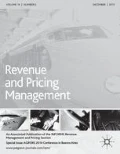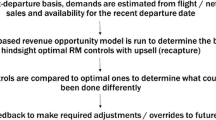Abstract
The revenue opportunity model (ROM) is a widely known method for measuring revenue management (RM) performance. While adapting the ROM to recent developments of RM science, the question of applicability and in particular the validity of the ROM became increasingly important. In this article, we introduce a novel simulation-based approach to measure the robustness of the ROM against errors in the input data. We also test the robustness of the network-based ROM for airline RM with independent demand on realistic data and present computational results.













Similar content being viewed by others
References
Adler, A. (1993) Performance Measurement Issues in Yield Management. AGIFORS 33rd Annual Symposium Proceedings; Chicago, USA.
Armstrong, J. (2001) Principles of Forecasting: A Handbook for Researchers and Practitioners. Norwell, MA: Kluwer Academic Publishers.
Bach, T. (1999) Yield Management & Human Intervention. AGIFORS Reservations and Yield Management Study Group Annual Meeting Proceedings; London, England.
Barnhart, C., Belobaba, P. and Odoni, A.R. (2003) Applications of operations research in the air transport industry. Transportation Science 37 (4): 368–391.
Chandler, S. and Ja, S. (2007) Revenue Opportunity Modeling at American Airlines. AGIFORS Reservations and Yield Management Study Group Annual Meeting Proceedings; Jeju, Korea.
Chiang, W.-C., Chen, J.C. and Xu, X. (2007) An overview of research on revenue management: Current issues and future research. International Journal of Revenue Management 1 (1): 97–128.
Cross, R.G. (1995) An introduction to revenue management, In: Jenkins, D. (ed). The Handbook of Airline Economics, pp. 443-468. New York, NY: The Aviation Weekly Group of the McGraw-Hill Companies.
Curry, R.E. (1992) Performance measurement: Who needs it? Scorecard – The Revenue Management Quarterly, Third Quarter: 1–4.
Dar, M. (2006) Modelling the performance of revenue management systems in different competitive environments. Master thesis, Massachusetts Institute of Technology.
Frank, M., Friedemann, M. and Schröder, A. (2008) Principles for simulations in revenue management. Journal of Revenue and Pricing Management 7 (1): 7–16.
Kempka, D. (1991) Measuring Yield Management Effectiveness. AGIFORS Reservations and Yield Management Study Group Annual Meeting Proceedings; Minneapolis, USA.
Mak, C. (1992) Revenue impacts of airline yield management. Master thesis, University of Waterloo, Ontario, Canada.
McGill, J. and van Ryzin, G. (1999) Revenue management: Research overview and prospects. Transportation Science 33 (2): 233–256.
Pölt, S. (2001) Looking for feedback – performance measurement in revenue management. AGIFORS Reservations and Yield Management Study Group Annual Meeting Proceedings; Bangkok, Thailand.
Rannou, B. and Melli, D. (2003) Measuring the impact of revenue management. Journal of Revenue and Pricing Management 2 (3): 261–270.
Smith, B.C., Leimkuhler, J.F. and Darrow, R.M. (1992) Yield management at American Airlines. Interfaces 22 (1): 8–31.
Talluri, K. and van Ryzin, G. (2004) Theory and Practice of Revenue Management. Boston, MA: Kluwer Academic Publishers.
Temath, C., Frank, M. and Pölt, S. (2009) On the Robustness of the Network Based Revenue Opportunity Model. AGIFORS Reservations and Yield Management Study Group Annual Meeting Proceedings; Amsterdam, Netherlands.
Vinod, B. (2006) Measuring revenue management performance. Ascent 1: 14–19.
Zeni, R. (2001) Improved forecast accuracy in revenue management by unconstraining demand estimates from censored data. Doctoral dissertation, Newark, NJ: State University of New Jersey.
Zeni, R. (2003) The value of analyst interaction with revenue management systems. Journal of Revenue and Pricing Management 2 (1): 37–46.
Author information
Authors and Affiliations
Corresponding author
Additional information
gchairs the Decision Support & Operations Research Lab at the University of Paderborn, Germany. Her research focuses on planning for public transport and logistics with special regard to optimisation, simulation and robust planning.
Rights and permissions
About this article
Cite this article
Temath, C., Pölt, S. & Suhl, L. On the robustness of the network-based revenue opportunity model. J Revenue Pricing Manag 9, 341–355 (2010). https://doi.org/10.1057/rpm.2010.15
Received:
Revised:
Published:
Issue Date:
DOI: https://doi.org/10.1057/rpm.2010.15




